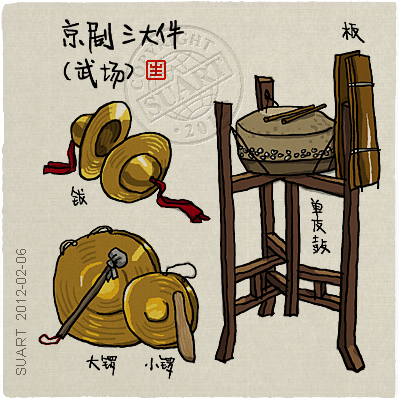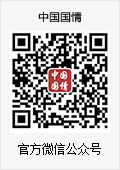京剧文化之旅 |“无曲不成戏” 京剧舞台的“场面”——京剧乐队
京剧文化之旅 |“无曲不成戏” 京剧舞台的“场面”——京剧乐队
No Music, No Opera
Why Instrumental Bands Are Important for Beijing Opera
生活中大家偶尔会提到一个词“撑场面”,指的是制造或维持表面的排场。而在京剧中“支撑整个舞台场面”的伴奏就是指京剧乐队,通过乐器与演员的“唱”“念”“做”相配合,渲染了气氛又烘托出演员的表演,能有效提升整个剧目的情景与演出效果。
The term“Changmian” (literally,“keeping up appearance”) is used from time to time indaily life,which refers to creation or maintenance of superficial pomp. On the stage of Beijing Opera,it is the instrumental band that “keeps up appearance”. Through the coordination between instrumental music and artists’ singing, reciting and acting, the stage atmosphere is heightened and artists’ performances are highlighted, thus effectively improving the theatrical effect of the whole play.
那么你知道京剧乐队为什么被叫做“场面”吗?“文场”与“武场”有什么区别?
Do you know why a Beijing Opera band is called“Changmian”? What is the difference between Wenchang (singing and reciting) and Wuchang (acrobatic fighting)?
“场面”之称的由来
The Origin of “Changmian”
与现代京剧不同,早期戏曲舞台装置较为简陋,在方形戏台的中后部台幔(或板壁)之前(即上、下场门之间),摆放着桌椅和乐器,乐师们分别就座入位,执弦、管乐器的在左方,操锣者在右方,掌鼓板的鼓师居中。所谓"场面"原指的是"场上正面"的这种设置形式,因而逐渐对这种演奏组织也就称为"场面"。后来乐队位置移于舞台下场门侧,但仍保留“场面”这一称呼。
Unlike present-day Beijing Opera, in its early days,Beijing Opera featured simple stage setting. In front of a cloth curtain (or wooden partition) placed on the rear of a square stage, where artists entered or stepped down from the stage, there were tables, chairs and musical instruments. The instrumentalists were seated in fixed positions, with those who played stringed instruments or wind instruments on the left, the gong players on the right, and the drum players in the middle. The word “Changmian” originally referred to such stage setting.Later, the instrumental band moved to the offstage side, but the word “Changmian”has been retained.
京剧乐队是由打击乐器和管、弦乐器组成的。拉弦乐、弹拨乐和吹管乐称为“文场”,打击乐器称为“武场”,所以京剧乐队也称为“文武场”这一称呼。
A Peking band consists of percussion, wind, and stringed instruments.A performance using stringed, plucked and wind instruments is called Wenchang,while a performance using percussion instruments Wuchang. Therefore, Beijing Opera bands are also called “Wenwuchang”.
“文场”与“武场”
Wenchang and Wuchang
“文场”:京剧伴奏中的管弦乐队称为文场。一般重唱工的文戏,以管弦乐伴奏为主(虽也少不了打击乐),因此传统习惯称管弦乐为文场。文场常用乐器是京胡、京二胡、月琴、小三弦、秦琴、中阮、大阮、笛子、唢呐、笙等。
A band that plays stringed and wind instruments in Beijing Opera is called Wenchang. The singing scenes are usually accompanied by stringed and wind instruments (although percussion musicis indispensable), hence the name Wenchang meaning “civil section”.The instruments commonly used inWenchang include jinghu (a two-stringed bowed instrument with a high register),jingerhu (a two-stringed bowed instrument),yueqin (a four-stringed plucked instrument with a full-moon-shaped sound box),xiaosanxian (a smaller three-stringed plucked instrument),qinqin (a stringed instrument),zhongruan (a medium-sized plucked stringed instrument),daruan (a larger plucked stringed instrument), flute,suona (a woodwind isntrument), reed pipe, and so on.

@SUART 京剧三大件(文场)
Three major instruments ofBeijing Opera (Wenchang)
“武场”:京剧伴奏中的打击乐队称为武场。打击乐器虽然只能奏出一个有固定高低的音,但音响强烈,节奏感鲜明,一般重武打的武戏,以打击乐伴奏为主,因此传统习惯称打击乐为武场。武场常用乐器是板鼓、大锣、铙钹、小锣、大小堂鼓等。
Wuchang refers to the band that plays percussion instruments. Percussion instruments only have one fixed pitch, but they can make strong sound and distinct rhythm. Percussion instruments are usually played in acrobatic fighting scenes,hence the name Wuchang meaning “martial section”. Instruments such as bangu (a single-headed frame drum), big gong, cymbals, small gong,and drums are frequently used inWuchang.

@SUART 京剧三大件(武场)
Three major instruments of Beijing Opera (Wuchang)
京剧乐队的艺术渲染力
Artistic appeal of Beijing Opera bands
在戏曲舞台上,有时候会运用乐器渲染气氛,铺陈情节,塑造人物。每种乐器性能各异、音乐色彩不一,所表现的情景、传达的意境也不同。打击乐有表现各种意境和情感的锣鼓经,管弦乐也有渲染各种气氛和各种心情的曲牌和其他丰富的表现手法。
On the stage of Beijing Opera,instruments are sometimes used to heat up the atmosphere,mark advancements of plots and help the depiction of characters. Various musical instruments with diverse functions and tones are used to depict different scenes and express different artistic connotations. Among percussion instruments, gongs and drums can express various artistic connotations and emotions. Wind and stringed instruments can also create the atmosphere and showcase moods with various tunes and techniques.
常常人们听到主奏乐器,即能判明是什么剧种或声腔在演出,乐器伴奏对唱腔起着引、承、托、帮的作用:
People can often tell the type of opera or tune when hearing the main instrument. Instrumental accompaniment plays a role in introducing, transiting,setting off, and assisting vocal performances.
引--用或长或短的引奏把唱腔引带出来,使演员有调高、节奏的准备
Introducing: to bring out the singing with a short or long overtune and get the artists prepared
承--起着唱腔间隙的桥梁作用
Transiting: to bridge two pieces of singing
托--衬托唱腔,使唱腔丰满,音色多变
Setting off: to make the singing and tunes more diverse and changeable
帮--使演唱者的情绪发挥得更加充分
Assisting: to help the performers fully express emotions
(部分图片来自网络,如有侵权请联系删除)

